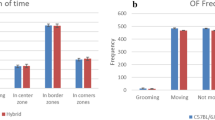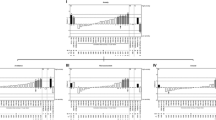Abstract
PWD/Ph is an inbred mouse strain derived from wild mice trapped in central Czech Republic. These mice are of the Mus musculus musculus subspecies, whose ancestors separated from those of Mus musculus domesticus about one million years ago. There is a high degree of variation in the genomic sequence and a wide range of phenotypes between PWD/Ph and standard laboratory inbred mouse strains, the genomes of which are principally Mus musculus domesticus in origin, making PWD/Ph mice an useful resource for complex trait research. As a first step in taking advantage of this resource, a preliminary characterization of the behavior of PWD/Ph mice was performed. Groups of 10 PWD/Ph and C57BL/6J male mice were tested in the open field, novel object exploration task and Morris water maze. PWD/Ph were marginally more anxious than C57BL/6J mice in the open field but subsequently displayed much higher levels of exploration and lower anxiety than C57BL/6J mice following introduction of a novel object. As C57BL/6J itself is rated as highly explorative among classical inbred strains, PWD/Ph probably represents an extreme among mouse strains for this specific behavior. PWD/Ph and C57BL/6J mice differed in their water escape training profiles in the Morris water maze, perhaps reflecting different motivational factors. However, there were no differences in overall cognitive ability (spatial learning) as both groups learned to find the hidden platform and performed equally well when the location of the platform was changed. This is the first quantification of the behavior of PWD/Ph mice and the results are promising for the potential of the consomic panel currently being generated with PWD/Ph and C57BL/6J as a tool for the molecular dissection of behavior.
Similar content being viewed by others
REFERENCES
Allan, A. M., Chynoweth, J., Tyler, L. A., and Caldwell, K. K. (2003). A Mouse Model of Prenatal Ethanol Exposure Using a Voluntary Drinking Paradigm. Alcohol Clin. Exp. Res. 27:2009–2016.
Archer, J. (1973). Tests for emotionality in mice and rats:a review. Anim. Behav. 21:205–235.
Blanchard, R. J., Hebert, M. A., Ferrari, P., Palanza, P., Figueira, R., Blanchard, D. C., and Parmigiani, S. (1998). Defensive behaviors in wild and laboratory (Swiss)mice:the mouse defense test battery. Physiol. Behav. 65:201–209.
Bolivar, V. J., Caldarone, B. J., Reilly, A. A., and Flaherty, L. (2000). Habituation of activity in an open-field:a survey of inbred strains and F1 hybrids. Behav. Genet. 30:285–293.
Bonhomme, F., and Guenet, J.-L (1996). The laboratory mouse and its wild relatives. In M. F. Lyon, S. Rastan, and S. D. M. Brown (eds. ), Genetic variants and strains of the lab-oratory mouse. Oxford: Oxford University Press, pp. 1577–1596.
Candland, D. K., and Nagy, Z. M. (1969). The open eld:some comparative data. Ann. NY Acad. Sci. 159:831–851.
Crawley, J. N., Belknap, J. K., Collins, A., Crabbe, J. C., Frankel, W., Henderson, N., Hitzemann, R. J., Maxson, S. C., Miner, L. L., Silva, A. J., Wehner, J. M., WynshawBoris, A., and Paylor, R. (1997). Behavioral phenotypes of inbred mouse strains:implications and recommendations for molecular studies. Psychopharmacology 132:107–124.
Crawley, J. N., and Davis, L. G. (1982). Baseline exploratory activity predicts anxiolytic responsiveness to diazepam in five mouse strains. Brain Res. Bull. 8:609–612.
D’ Hooge, R., and De Deyn, P. P. (2001). Applications of the Morris water maze in the study of learning and memory. Brain Res. Rev. 36:60–90.
Festing, M. F. W. (1999). Inbred strains of mice. Mouse genome informatics. Bar Harbor, Maine: The Jackson Laboratory. World Wide Web (URL:http://www. informatics. jax. org/).
Flint, J. (2003). Analysis of quantitative trait loci that in. uence animal behavior. J. Neurobiol. 54:46–77.
Grailhe, R., Waeber, C., Dulawa, S. C., Hornung, J. P., Zhuang, X., Brunner, D., Geyer, M. A, and Hen, R. (1999). Increased exploratory activity and altered response to LSD in mice lacking the 5-HT5 A receptor. Neuron 22:581–591.
Gregorova ´, S., and Forejt, J. (2000). PWD/Ph and PWK/Ph inbred mouse strains of Mus m. musculus subspecies –a valuable resource of phenotypic variations and genomic polymorphisms. Folia Biol. (Praha) 46:31–41.
Hall, C. S. (1951). The genetics of behaviour. In Steven, S. S. (ed. ), Handbook of experimental psychology, New York: John Wiley & Sons Inc, pp. 304–329.
Holmes, A., Parmigiani, S., Ferrari, P. F., Palanza, P., and Rodgers, R. J. (2000). Behavioral pro le of wild mice in the elevated plus-maze test for anxiety. Physiol. Behav. 71:509–516.
Holmes, A., Wrenn, C. C., Harris, A. P., Thayer, K. E., and Crawley, J. N. (2002). Behavioral pro les of inbred strains on novel olfactory, spatial and emotional tests for reference memory in mice. Genes Brain Behav. 1:55–69.
Koide, T., Moriwaki, K., Ikeda, K., Niki, H., and Shiroishi, T. (2000). Multi-phenotype behavioral characterization of inbred strains derived from wild stocks of Mus musculus. Mamm. Genome. 11:664–670.
Le Roy, I., Roubertoux, P. L., Jamot, L., Maarouf, F., Tordjman, S., Mortaud, S., Blanchard, C., Martin, B., Guillot, P. V., and Duquenne, V. (1998). Neuronal and behavioral differences between Mus musculus domesticus (C57BL/6JBy) and Mus musculus castaneus (CAST/Ei) Behav. Brain Res. 9595:135–142.
Lipp, H. P., and Wolfer, D. P. (1998). Genetically modified mice and cognition. Curr. Opin. Neurobiol. 8:272–280.
Logue, S. F., Owen, E. H., Rasmussen, D. L., and Wehner, J. M. (1997). Assessment of locomotor activity, acoustic and tactile startle, and prepulse inhibition of startle in inbred mouse strains and F1 hybrids:Implications of genetic background for single gene and quantitative trait loci analyses Neuroscience 80:1075–1086.
Misslin, R., and Ropartz, P. (1981). Responses in mice to a novel object Behaviour 78:169–177.
Morris, R. G., Garrud, P., Rawlins, J. N., and O'Keefe, J. (1982). Place navigation impaired in rats with hippocampal lesions Nature 297:681–683.
Mouse Genome Sequencing Consortium (2002). Initial sequencing and comparative analysis of the mouse genome Nature 420:520–562.
Owen, E. H., Logue, S. F., Rasmussen, D. L., and Wehner, J. M. (1997). Assessment of learning by the Morris water maze task and fear conditioning in inbred mouse strains and F1 hybrids: implications of genetic and background for single gene muta-tions and quantitative trait loci analysis Neuroscience 80:1087–1099.
Silver, L. (1995). Mouse genetics concepts and applications. Oxford: Oxford University Press.
Stavnezer, A. J., Hyde, L. A., Bimonte, H. A, Armstrong, C. M., and Denenberg, V. H. (2002). Differential learning strategies in spatial and nonspatial versions of the Morris water maze in the C57BL/6J inbred mouse strain Behav. Brain Res. 133:261–270.
Tang, X., Orchard, S. M., and Sanford, L. D. (2002). Home cage activity and behavioral performance in inbred and hybrid mice Behav. Brain Res. 136:555–569.
Trullas, R., and Skolnick, P. (1993). Differences in fear motivated behaviors among inbred mouse strains Psychopharmacol. 111:323–331.
Upchurch, M., and Wehner, J. M. (1988). Differences between inbred strains of mice in Morris water maze performance Behav. Genet. 18:55–68.
van der Staay, F. J. (2000). E. ects of the size of the Morris water tank on spatial discrimination learning in the CFW1 mouse Physiol. Behav. 68:599–602.
van Gaalen, M. M., and Steckler, T. (2000). Behavioural analysis of four mouse strains in an anxiety test battery Behav. Brain Res. 115:95–106.
Voikar, V., Koks, S., Vasar, E., and Rauvala, H. (2001). Strain and gender di. erences in the behavior of mouse lines commonly used in transgenic studies Physiol. Behav. 72:271 – 281.
Wade, C. M., Kulbokas, E. J. III, Kirby, A. W., Zody, M. C., Mullikin, J. C., Lander, E. S., Lindblad-Toh, K., and Daly, M. K. (2002). The mosaic structure of variation in the laboratory mouse genome Nature 420:574–577.
Webster, D. G., Baumgardner, D. J., and Dewsbury, D. A. (1979). Open-field behavior in eight taxa of muroid rodents Bull. Psychonom. Soc. 13:90–92.
Wiltshire, T., Pletcher, M. T., Batalov, S., Barnes, S. M., Tarantino, S. M., Cooke, M. P., Wu, H., Smylie, K., Santrosyan, A., Copeland, N. G., Jenkins, N. A., Kalush, F., Mural, R. J., Glynne, R. J., Kay, S. A., Adams, M. D., and Fletcher, C. F. (2003). Genome-wide single-nucleotide polymorphism analysis defines haplotype patterns in mouse P. N. A. S. 100:3380–3385.
Wolfer, D. P., Stagljar-Bozicevic, M., Errington, M. L, and Lipp, H.-P. (1998). Spatial memory and learning in trans-genic mice:fact or artifact? News Physiol. Sci. 13:118–123.
Author information
Authors and Affiliations
Rights and permissions
About this article
Cite this article
Fernandes, C., Liu, L., Paya-Cano, J.L. et al. Behavioral Characterization of Wild Derived Male Mice (Mus musculus musculus) of the PWD/Ph Inbred Strain: High Exploration Compared to C57BL/6J. Behav Genet 34, 621–630 (2004). https://doi.org/10.1007/s10519-004-5589-y
Issue Date:
DOI: https://doi.org/10.1007/s10519-004-5589-y




